#notes. ( “LINCEI” );
Explore tagged Tumblr posts
Text
'Part I of this essay reflecting on the new film Oppenheimer discussed the moral quandary that Oppenheimer faced as his team approached completion of the bomb. His argument that dropping the bomb would be a trigger for the creation of a world government that would usher in world peace was a failure of moral and political reasoning. But it was perhaps more likely that he so failed to reason given that his misconception of both nature and grace derived from his understanding of the scientific vocation as an agnostic enterprise, untutored by faith in God.
The scientist who does not understand his vocation under the wings of God’s providence and grace doesn’t really understand what he observes under the microscope. In reality, he finds there, in Kepler’s words, the “spirit and trace of God” in creation, not merely godless and purposeless “stuff” that is rightfully manipulated at will by man. On this point, Oppenheimer’s contemporary, Pope Pius XII, saw the truth with clarity.
Of course, any mention of the Venerable Servant of God Pius XII in this context must note that he has been subject to all sorts of attacks on his conduct during World War II, summed up in the epithet “Hitler’s Pope.��� While this is not the place to adjudicate those historical arguments, suffice it to say that if the most recent iteration of the Pius Wars is any indication, the critiques of him have tended to ignore inconvenient evidence and amounted to slander. The most recent study, aided with expanded access to Vatican archives, has shown that Pius opposed the Nazis’ racist ideology, worked against Nazi tyranny, and helped save the lives of thousands of Jews.
In his remarkable 1948 address to the Pontifical Academy of Sciences, Pope Pius XII laid out a Christian perspective on science. It was a fitting setting, for the Academy’s history is a witness to the Church’s high valuation of the natural sciences. The Pontifical Academy of the Sciences has its roots in the Accademia dei Lincei under Clement VIII in 1603, one of the first academies established specifically for the purpose of scientific study of the natural world and of which Galileo was eventually a member. It was reestablished by Pius IX in the 19th century and Pius XI reconstituted and renamed the Academy in 1936.
Pius identified ours as “The Atomic Age,” as demarcated by the creation of the bomb, “the most terrible weapon, which the human mind has, up to now, devised.” After a thumbnail historical sketch highlighting the progress of physics’ understanding of the atomic world that culminated in the capacity to harness the energy from the atom, the pope offered praise to the scientist’s vocation: “Wonderful achievements of the human intellect, which scrutinizes and investigates the laws of nature, dragging humanity with it along new paths! Could there be a more noble conception?”
But he went on to insist that the scientific vocation must be embraced under God. In denying that he is peering into the order God designed, he suggested that the agnostic scientist lacks an upright impulse for humility. In other words, when the scientific vocation is framed as an agnostic enterprise, the scientist is apt to fancy himself a god, which is precisely what Oppenheimer’s story illustrates.
The human heart—Oppenheimer knew all too well—is restless. The film doesn’t include the fact that he loved quoting from George Herbert’s poetry and knew The Pulley. The poem recounts how God bestows upon man all manner of gifts, including honor, pleasure, and wisdom, but withholds from man rest:
But keep them with repining restlessness; Let him be rich and weary, that at least, If goodness lead him not, yet weariness May toss him to my breast.
Yet, it doesn’t appear that Oppenheimer’s weariness ever tossed his restless heart to the bosom of his Creator. As an agnostic, he never returned to the faith of his Hebrew ancestors. When his friend Isidor Rabi heard Oppenheimer had taken up Sanskrit in earnest so that he could read the Bhagavada Gita, the Hindu scripture, Rabi was perplexed: “Why not the Talmud?” Nor, apparently, did he have faith in Donne’s “three-person’d God,” which inspired him to name the bomb’s testing site “Trinity.” And, of course, the notions that Niels Bohr was his “god,” and Oppie his “prophet” were not meant literally. That was a tongue-in-cheek metaphor for Oppenheimer’s real faith. In truth, Bohr came late into the Manhattan project to offer his advice to Oppenheimer as his peer, not as a god to his prophet.
Oppenheimer’s faith was in Science, which is to say, his was a Baconian faith in man and man’s ability to conquer and master nature for man’s own knowledge and power using the scientific method. As Oppenheimer explained in a 1945 lecture to the American Philosophical Society, the substance of scientists’ faith was “the general recognition of the value, the unqualified value of knowledge, of scientific power and progress.” This was the object to which his restless heart was directed. As his friend Freeman Dyson observed: “Restlessness drove him to his supreme achievement, the fulfillment of the mission of Los Alamos . . . ”
It is possible to set aside the politically naïve component of Oppenheimer’s argument for the bomb and focus in on the knowledge argument. Oppenheimer believed that, in the name of scientific power and progress, the scientific secret of Los Alamos needed to be revealed to the world. In Promethean fashion, Oppenheimer, in the name of Science, offered atomic fire to the world (which could be used for peaceful objects like generation of power). But if correct, this underscores the peril of reason unmoored from faith, since idols, even if they promise some good, always demand sacrifice.
As the film narrates, the moment the first bomb was successfully tested at Los Alamos, Oppenheimer’s thoughts went to (a paraphrase of) the god Vishnu’s line in the Gita: “Now I am become death, the destroyer of worlds.” There is some debate about what he really meant here. I think Oppenheimer glimpsed himself (literally, symbolically, and synecdochally) in that moment, albeit, perhaps in spite of himself. His free choice to direct his restlessness toward the creature rather than the Creator was the condition of becoming such a “god.” The testimony of Oppenheimer’s neighbor on St. John suggests he relished this. She witnessed Oppie’s festivities on the anniversary of the dropping of the bomb and remarked that “he transparently loved the Bomb and his lordly role in its creation.” Synecdochally, it could be said that Science, or perhaps more accurately, the new Scientist, had become a most terrible god, as all idols must.
And yet, as the film accurately (and cleverly) portrays, Oppie was a man of tortured conscience. Almost immediately, Oppenheimer experienced the pangs of guilt over the “poor little people,” e.g., the tens of thousands of Japanese men, women, and children civilians who were incinerated or died later from radiation poisoning. Perhaps his conscience was convicting him that, inasmuch as their fiery and radioactive deaths were offered as a sacrifice in the name of Science, the cost was too high. Even though Oppenheimer himself doesn’t seem to have admitted this in so many terms, he did admit in a 1965 television interview (which is not in the film), that he and his fellow physicists had “known sin,” the sin of pride, by thinking they knew what was best for man and the world.
Among the sacrificial victims of the bomb dropped on Nagasaki at 11:02 am on August 9, 1945, were two Roman Catholic priests, Frs. Saburo Nishida and Fusayoshi Tamaya, and about thirty of their parishioners who were gathered for confession in Urakami Cathedral, about 500 meters from ground zero of “Fat Man.” They all died instantly. Hibaku no Maria, also known as Our Lady of Nagasaki, with her charred face and burnt out eyes, is an enduring and haunting witness to the evils of that day.
As Frs. Nishida and Tamaya could have explained to Oppenheimer, the conviction of sin in one’s conscience generates the objective needs of confession and penance. And so it isn’t surprising that Oppenheimer in his first interview with President Truman shortly after the bombs dropped, said: “I feel I have blood on my hands.” But Truman did not (and indeed, could not) offer him the absolution he sought.
So Oppenheimer imposed a penance on himself: to spend the next several years advocating for international nuclear control and, when he realized that the Marxist ideology of the Soviets prevented them from cooperating with the West, he advocated restraint in development of America’s nuclear arsenal, opposing the hydrogen bomb’s creation. (The film also suggests that he chose to endure the kangaroo court as a form of penance.) His argument for restraint was not unreasonable. In order to avoid triggering a hydrogen bomb arms race, the United States should not test one, since Russia would be forced to respond in kind. Perhaps a window was open for an H-bomb test ban treaty that would be self-enforcing, since any such test could be detected. On the other hand, Oppenheimer didn’t seem to appreciate the moral force of the counterargument that, once the nuclear cat was out of the bag, nuclear armament in the face of a mendacious enemy hellbent on spreading communist tyranny around the globe, combined with a no first strike policy, was prudent statecraft. As the neorealists would argue, when nuclear powers have arsenals with second-strike capacities, it actually has a stabilizing effect, since it makes the cost of using nuclear weapons too high to be rational.
In the end, Oppie’s opposition was interpreted or portrayed by his opponents as disloyalty rather than mere dissent, which they used to orchestrate his political downfall. The U.S. and Soviet Union proceeded to create thousands of hydrogen bombs that were thousands of times more powerful than the bombs dropped on Hiroshima and Nagasaki.
Oppenheimer closes ominously with a closeup on the man. He is standing alone, stone-faced and porkpie-hatted, brooding on what he has unleashed on the world. Perhaps the takeaway is that brooding alone is the fate of the scientist who makes Science into his god.'
#Oppenheimer#George Herbert#'The Pulley'#Bhagavad Gita#John Donne#'Three Person'd God'#Freeman Dyson#Los Alamos#President Truman
0 notes
Text

SUBJECT: characters most relevant to the lore, be it by importance, how they've shaped and affected the world, or by their relation to ignis. tw: frequent mentions of drugs / narcotics, implied transphobia, implied rape, mentions of body dysmorphia, super long post.

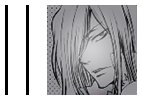
≥ FILE 020: CONQUEST_
given name lucius. codename derived from his true name. the horseman of conquest and pestilence, he is the one that had given birth to the organization known as 'gonchiye.' translated from russian to mean 'hunting dogs,' it is advertised as a supernatural police force of sorts, meant to upkeep the law and balance in the society of non-humans. the truth is much more ominous than this noble goal lucius presents it to the public with.
the gonchiye was built upon the remains of an ancient pit fighter ring, where humans would imprison supernatural beings through the use of binding magic and make them fight for their entertainment. as time consumes all, lucius had eventually only found a sole survivor of it all— and decided to use this one as a test vessel for a new plague he was developing for the inevitable apocalypse, that would be brought for once the time was nigh; lucius is the second oldest of the horsemen, and even though he rode first, he leaves leadership of the group to the eldest, death. he rides upon a white horse, going by the name glory, and his weapons of choice are a bow and arrows.
the truth beyond this organization is that it is the horseman's way of preserving world balance. each of the four horsemen has their own way of going about it, and while some are more questionable than others... in the end, it is for the greater good of the world. or so they say. many, especially mortals, have any sort of understanding to actually comprehend this divine task. for lucius, this means eliminating targets that, in his opinion, endanger this delicate balance, as well as constantly improving. this could mean many things— be it in regards to biological or technological advancements. one could very easily classify the nephilim as a mad scientist, and they wouldn't be wrong.
lucius has an odd quirk in that he never uses abbreviations, verb conjugations, or contractions. his manner of speech is very proper, if not outright snobby. he is by no means a coward, but he is the type to make others do his bidding for him; it's the very reason why he utilizes the hundred of agents ( there are no more than a hundred active agents at any given time ) within the gonchiye to carry out tasks for him. tasks that are masterfully masked so that the true ambition behind them isn't discovered. generally speaking, there is but a handful of people within the organization aware of the truth, and all of those are under tight scrutiny— to the point of being collared with a collar infused with a special serum meant to make these beasts docile and easily compliant with his wishes. it isn't humane.
ignis is one such agent. once, he dared even to call lucius a friend. the two were rather close, due to them being of similiar ages. ignis is also one of the few people able to actually keep up against lucius in a fight. and they did fight. unfortunately, lucius possesses light magic, which is incredibly effective against an infernal like the hellhound— it has left him with an ugly scar across his chest. their friendship ended and relations became tense after ignis' failure with mission 298: to dispatch stormbringer.
with ignis' continual failures to deliver after that incident, he's set an execution order on him.

≥ FILE 057: LINCEI_
given name kalisha. codename derived from the italian accademia dei lincei, named after the lynx whose keen eye is neccessary for scientific research. kalisha is a nekomata of spanish and japanese origins, and was one of the very first members of the gonchiye. unlike most members who had joined voluntarily under the impression that they'd do some good in the world, to the lynx, it was offered as means of vengeance. kalisha harbors a deep hatred for humans from the times hunters had taken her husband and son, and she's never gotten over the loss. due to her then-violent tendencies, she was also one of the first agents to be collared.
the drug worked well, far too well perhaps, as not long after, her aggressive demeanor had mellowed out. a side-effect of this was the very prominent deepening of her voice, leaving it husky and nearly sounding like a chain smoker. once under control, she's been retired from field missions and was instead tasked with helping with the research— something that had allowed her quite the deep insight into the truth of just what lucius was aiming for. with her mind numbed like so, however, she did not have the willpower to do anything about it, other than simply play along.
that has changed once she was introduced to project talonshot. while their interactions were limited for the sake of conditioning naoto into a cold-hearted killer, she did end up doting on him and treating him like her own son. it could never be the same, and not just for the boy being different, but also due to the strict security within the gonchiye walls, she could never be as open with her affection as she could hope for. nevertheless? it gave her some hope and determination in perservering in these conditions.
ignis considers her his closest friend. both of them were early members, though she's never told him the truth about lucius and the things she's learned until much, much later. she believed she was protecting him this way. they had interest in each other at one point and had tried dating, but things never quite worked out, and so they simply stayed on friendly terms. she is someone ignis can talk about just anything, and he knows she has his back, while he has hers. they had numerously teased each other for their tastes in partners, especially once she'd learned that ignis had taken naoto as his lover and mate, but the truth was, she was very happy for them both; and would entrust her son to no one else.
kalisha eventually meets the current warlord of the red oni tribe and decides to stay with them ( or rather, they had rather forcibly kidnapped her from the gonchiye. she didn't resist or complain ) and become their queen as they became lovers and partners.

≥ FILE 094: NIHIL_
given name noctis. codename derived from his umbrakinesis and the ability to create black holes. about 500 years younger than his half-brother, he harbors immense jealousy towards ignis and has set out along with his cousin, eryx, to earth to seek him out and hopefully drag him back to their home in the underworld. was it selfish? certainly. did that stop them? no. noctis used to be rather clingy towards his older brother as a child, so seeing him run away from home like so was incredibly traumatizing; he practically idolized the hound.
contrary to his half-brother, who is the result of a hellhound and an erinye, noctis is a pureblooded erinye. he is rather apathetic and laughs at the misfortune of others. he is mean, but not neccessarily evil. his magic can be destructive and he can be rather ruthless in a fight. such talents had earned him the position of a saboteur; but not without a collar.
noctis is a trans man, but lucius knew that he possesses female biology, and took advantage of it. his genes were forcibly used in the creation of project talonslash, which has left the erinye with deep mental scars. he'd never felt insecure about his body until that very moment that someone abused it like so. as a result, he's come to loathe talon, even if the boy himself hadn't done anything wrong. long since losing ignis again after his exodus from the gonchiye did he not want to stay anymore, but getting out was never easy. this, though? this was the last straw.

≥ FILE 273: HELIOS_
given name sirius. codename derived from his title, 'the sun of the underworld.' sirius is the current hound of hades, something of a king of the hellhounds, inhering the title of cerberus that goes with it. such tradition is something ignis is aware of, therefore his bitterness about lucius choosing to designate the codename cerberus to him within the gonchiye.
sirius had an affair with tisiphone, an affair from which his ( currently ) only son was born. a bastard perhaps, but he still wished for him to take up the mantle of cerberus once it was time. unfortunately, tisiphone didn't agree with this; she wanted the child for herself, or at least, to have him make whatever choices he wished to later in life. fiercely protective, she hid herself and baby ignis within erebus, the shadowy pocket dimension of the underworld, only accessible to the erinyes and a few others. ignis did take after this fiery desire to be independent, maybe a bit too much, and yet, he felt like his mother was smothering him; not allowing him to leave erebus until... until what? he didn't know, and she never gave him the answer. eventually, he heard the call of hades; a call every hellhound must answer. one that only they hear, and cannot resist. under the influence of the call, he managed to break free of erebus.
that was the first time he and sirius met, some three hundred years since ignis' birth. perhaps a bit too enthusiastic to meet his son, sirius was quick to introduce ignis to just about everything that was to be expected out of him— once, they might have even ended up on good terms. but feeling that his father, too, wished to force his dreams and ideals onto him, ignis came to resent his father more than he did his mother. he swore to never become the next cerberus, or have anything to do with sirius at all. he avoided him like the plague.
sirius is an outgoing, charismatic, yet arrogant individual. he and ignis are quite alike, in both looks and personality, much to his dismay. nowadays, sirius realizes he might've been a little too pushy with ignis, and he regrets it greatly, as he would have loved to be on good terms with his son... he still hopes for as much, even if the rational part of him knows that will likely never happen.
another custom for the hound of hades is to take up two mates, so as to represent the other two heads of cerberus. sirius, dutiful as he is, eventually enters an arranged mateship with xolotl and tiangou, two guardian hellhounds from different cultures, later accepting the names of sol and luna, the sun and moon to sirius' star. this mateship is especially important in these trying times, where the guardian breed is near its extinction— sol is expected to carry the pups of both luna and sirius. this polyamory is yet another parallel between father and son, but ignis remains unaware of this so far.

≥ FILE 298: STORMBRINGER_
given name shinjou. codename derived from his ability to control lightning. this kitsune was the unfortunate patient zero as the sole survivor of the earlier-mentioned beast pit fight business. he was unaware of this predicament until much, much later, that this sickness had started to show itself. at first, it was simple nausea, then it turned into something akin to tuberculosis, and eventually, his very body had started to change.
shinjou is incredibly technically skilled, something of a mad scientist himself to rival lucius, but where lucius seeks the biological, shinjou is more interested in the mechanical. while being the head of a yakuza group called 'the order of the lotus,' in honor of his deceased father, he also owns a cybernetics company that specializes in highly advanced body implants and prosthetics. his twin brother had once lost an entire arm in a fight with a red oni ( this same oni had later also targeted shinjou and took his eye, leaving the fox blind in one eye ), and he was more than eager to provide for his brother with the technology he's developed. later in life he even attempts to build an adroid from scratch.
besides technology, shinjou is also a skilled sniper and hacker, on top of being a very influential person in kyoto— and slowly, all of japan, though for all the wrong reasons. the order had become feared, and its influence had even changed the widely-accepted meaning and symbolism of the lotus flower— where it once was a symbol of purity and rebirth, it is now something to be feared. shinjou experienced many hardships in his life, starting since childhood where he was exiled from the kitsune clan he lived in, for being born a twin, as twins were considered a bad omen. only one of the brothers was allowed to stay, and shinjou wasn't it— he never harbored any ill will against his parents or his brother for making that choice, however, only the clan elders. the twins were separated for most of their life before reuniting.
it only went downhill from there. getting caught and imprisoned within the fighting ring, which then cost his father's life, then getting used as a guinea pig, and even once he'd gotten out of all of that? he was adopted by a yakuza oyabun, who then taught him all that shinjou currently knows in regards to that kind of life. once the man had passed and shinjou took over, he renamed the group to honor his late father, and made it to be the most fearsome group kyoto had to ever deal with. all the misfortunes and abuse led to shinjou closing off his heart to love; and that was where ignis came into play, who'd, despite his own hardships, managed to stay soft and tender.
ignis was originally deployed as a long-time infiltrator agent into the order of the lotus, as per lucius' orders to learn all that there was, and then take him out before the plague had time to spread. this had gone on for twelve years, during which the hound, expectably so if you know anything about him, had developed romantic feelings for shinjou. he failed at pulling the trigger at the end, but shinjou still learned about the truth behind ignis' presence within the order— he was incredibly hurt by his betrayal, given just how much loyalty means to the fox. so much, that he insists every members gets a lotus tattoo ( hand for regular members, the neck for high ranked members ) to show their loyalty. and that's exactly what ignis did, and the fact that he bore the mark of the lotus and still stabbed him in the back like so? was something that broke the fox. one might have thought there was still some hope for salvation for him, but since then, he'd become unreasonably cold and cruel. he was letting no one close to him, ever again. even if later he'd found someone whom he calls a mate, a woman called abigail medusa, even with her the relationship is incredibly unstable and full of vitriol.
however, he still had to thank ignis. thank him for this opportunity to actually learn about the gonchiye, lucius, and the truth behind his undiagnosable illness. this meant war.
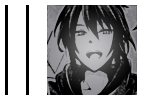
≥ FILE 309: TALONSLASH_
no given name. or? 'talonslash,' eventually simply referred to as 'talon' by his fellow agents for simplicity's sake ( despite lucius' disdain ) was purposefully left nameless upon his creation. project talonslash was meant to be the successor to project talonshot, which was, after ignis' influence and tampering, deemed a failure. the codename itself was derived from the mother project talon, plus a contrasting word to the original shot, as the birds were specialized as snipers.
talon is a very particular kind of a genetic experiment, as his dna consists of that of a tengu, falcon, and an erinye. noctis, to be specific. it was an ugly memory. this was made so that they could force his body into becoming resistant to physical stress, as that was deemed as one of talonshot's greatest weaknesses. they couldn't possibly make a durable bird assassin if they wanted him to remain swift and agile, and so, they went with the route that would make talon's body dissolve into shadows whenever exposed to immense physical trauma. therefore, it is incredibly difficult to actually wound him— if you manage to catch him in the first place. he struggles to actually control this side of himself, and everytime he is forced to dissolve like so, it leaves him feeling besides himself, in a nearly dissociative-like state.
his purpose, much like his predecestor's, is to be a living weapon. cold and heartless when taking the lives of his targets, and highly efficent at doing so. he is incredibly skilled with firearms as well as small hand weapons, such as knives. he also had extensive close quarters combat training, and while he excelled at it, it remains not his forte. talon much more prefers to pick his enemies off one by one from a safe distance, unseen. besides that, being agile as he is, usually leads to a more hit-and-run technique of fighting, plus he never properly learned how to handle and counter blows, due to how his body reacts to such assault. but given just what a dreadful feeling having to turn into a shadow leaves him in, he prefers to simply avoid getting hit altogether if he can help it.
despite his lack of identity and the ease at which he kills, he is a surprisingly bubbly and carefree character, if not a bit silly. naturally, he was allowed very little socializing and given even less affection while growing up, and while that had turned talonshot into the apathetic man that he is today, it seemed to have the very opposite effect on talonslash, leaving him childish and very eager to please. the primary person he seeks validation from is talonshot, whom he considers his older brother, even if their actual relation between them is a lot more complex. too bad he hadn't seen him for the majority of his life— only heard about him in stories, constantly compared to, and told just what kind of image he needed to live up to, and then subsequently surpass.
eventually, he was given the name hayato by none other than his brother upon finally meeting. as it is rather new to him, sometimes he still struggles to actually react to it should someone call him that— while he will always, without fail, respond to talon.
talon himself isn't incredibly important to ignis, rather he is important to his husband, naoto, and the one originally dubbed 'project talonshot.' their meeting and further interaction together was important for the development of them both; helping to find themselves among the scraps that the gonchiye had left them in.
honorable mentions, aka characters not played by me ( but @hellhunted ), but still very important:

≥ FILE 093: ORTHRUS_
given name eryx. codename derived from the mythological brother of cerberus, which was the designation assigned to ignis, due to the brother-like relation between the two. eryx joined the gonchiye together with noctis, hence their numbers following one another's. lucius was quite eager to have another hellhound at his disposal thanks to their unique ability of phasewalking.
eryx is a very... airheaded individual. a lot of things go over his head, but his heart is in the right place. he never truly saw the gonchiye for what it was; he and noctis only joined it as means of getting ignis back. eryx was collared nearly right from the start as precautionary measure, as lucius did not want to take any possible risks, having witnessed what troubles the elder hound could, and had, caused him.
ignis was something of an older brother to eryx while they were growing up together in the underworld. but where ignis ached to escape it, eryx wished to remain home. in his selfish desire for as much, ignis had abandoned the younger hound without a word on numerous ocassions. he feels great guilt about this all, but it just never seems like a good time to actually stop and tell him— and his cowardice prevents him from actually ever seeking him out and properly apologize. what kindship they had, is slowly dying out.

≥ FILE 308: TALONSHOT_
given name naoto. codename derived from the mother project talon, plus the word shot to signify his specialization as a sniper. talonshot was lucius' first attempt at dna splicing to create a perfect being with the exact kind of traits he desired. it was... mostly a success. naoto was intelligent and effective, and excelled at everything they put him to, which really mostly just involved assassinations with no feelings attached— something he noticed a lot of his agents often struggled with. to separate their duty from their emotions. ignis especially. but what was especially important and unique about naoto? was that, since he was just the first prototype at this kind of bioengineering for the future, he was also made disposable. 'talonshot' had an expiration date.
talonshot's purpose was to take care of the most important mission lucius had once entrusted ignis with— nowadays he really wonders just why he'd ever trusted that sap with something like this —to take out stormbringer. not only was naoto then succumbed to years of intense training to make sure he was ready for that encounter, his blood was also, since birth, infused with the antibody to the horseman's plague. he was meant to contain the plague, to get rid of the first specimen who wasn't meant to escape, before it started to spread prematurely, before the world was ready for the apocalypse. a clean state for the world was neccessary, but the time had to be right.
however, ignis was still the only person who had the most experience with stormbringer and as such, he was assigned as naoto's handler once he was out of initial basic care and training. they were still sent out on numerous other missions in gonchiye's name, but the long-term goal was to make sure that talonshot knew how to properly employ all that he'd learned against his main target.
you cannot teach new tricks to an old dog though, so long story short, the two ended up falling in love. it was true that at first, ignis despised naoto and all that he was meant to represent, but more importantly— he despised just how all the higher-ups were treating him. like he wasn't a living, breathing being. it took years upon years to make naoto believe that that was who he was; his true name, and not 'talonshot.' ignis strongly believed that he could be an efficent killer if that was who he wished to be, but he didn't need to completely forego his identity for it— and so, the many years of secret relationship were also a lot about helping naoto discover who he was behind all the guns and bullets.
they eventually made it to japan again, fully determined to see talonshot's mission to completion, only for the kitsune to prove a much deadlier foe than either of them had anticipated. ignis' direct orders were to not interfere, to let naoto handle it himself. but once he saw his boyfriend, his mate, nearly on death's door? he didn't hesitate. he'd saved him, paid a heavy price for it as he'd transformed into his true form to do so, and in the end, he still left the fox to live. his mate was alive, but he'd effectivelly ruined all he was working to achieve. enough said that naoto was furious at him— and so was lucius, which eventually led to him marking ignis as a traitor, and a kill order was issued on the hound.
naoto eventually forgave ignis, in fact, he'd eventually even proposed to the hound— the first man to ever do so, no less —and once he was chased out of the gonchiye, he followed after him. they've been on the run ever since, trying for some measure of a normal life, only to be crossed by the more loyal gonchiye agents on a handful of ocassions— until they met rashida and her resistance.
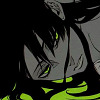
≥ FILE 388: SERQET_
given name rashida. codename derived from the goddess that she was a priestess of in her human life. the first human ignis had ever come into contact upon earth; and also his first ( and, romantically enough, also last ) lover and mate. she was the one to teach him about humanity with a hands-on approach, she was the one to teach him the first human language ( ancient egyptian ) and how to live like a human. due to an injury acquired from his less-than-graceful escape from the underworld, ignis was stuck in his demon form for a good while before recovering, making that a little troublesome; the locals had come to believe that he was an avatar of anubis coming to bless them. once discovered a fraud, both him and rashida were chased out of the temple.
since rashida had shown him her own home, ignis suggested they visit greece; his home on the mortal plane. it was there, closer to the magic of the gods, that he managed to mend the damaged mortal seal and take on a proper human guise. they'd been separated on numerous accounts, oftentimes by means outside either of their's powers, and yet each time, they found their way back to one another. one time she'd died, not long after ignis was recalled back to the underworld against his own will upon hearing the call of hades once again ( as it was louder within greece— for that reason, he now avoids the country ), as many mortal human would, which was something ignis should have expected... and he did, and yet? he couldn't accept it. especially because it wasn't death by natural means. he came to beg persephone to have her resurrected— such a selfish wish of a selfish lover, not at all caring about the consequences it might have had on her. the goddess told him as much, but he wouldn't take no for an answer; eventually tasked to find her soul that had passed on so that she could protect it personally for the times to come, while the spring deity worked with the egyptian goddess serqet to help restore the woman's body.
it... proved problematic, naturally. suddenly inhabiting a soulless vessel, turned into a demon like so, and all for the canine's selfishness and inability to let go. he was warned, but he was willing to face it head on, and was given another hundred years together with her— to help her learn about herself, her new body, her new demonic abilities. it was rough, as the reborn demoness despised herself for being this way, that ignis had done this to her... it took a long time of learning and self-reflection for rashida to accept both herself and him, before... ignis was called back once again, now that his hundred years were up. not that he was willing to stay, but another escape proved more problematic than the last, far too much to actually still be able to find his lover where he'd unwillingly left her on earth. since then? he hasn't seen her again... not for another two thousand years.
due to her own traumas of being reincarnated and forcibly turned into a demon ( and therefore stripped of her soul ) found the drive to fight against the gonchiye and the horsemen, to protect the humanity. even if she didn't possess her own anymore, she still holds humans dear to her heart, and simply couldn't accept what the horseman was doing. she, and many others outside the system, had discovered the truth, and a lot of it was thanks to all the wrenches ignis and naoto had thrown into lucius' plans. an alliance between mortals and immortals was formed, and came to known as the resistance against the coming apocalypse; though more importantly, against all the inhume methods the horseman of conquest is employing to upkeep his precious balance. lucius still insists these puny beings cannot understand the neccessity and importance of a world reset, and so, these two factions are now at war.
these were the two thousand years that had passed, until she's met ignis again— though this time, now a married man. it hurt her heart, certainly, as did the hound's, given just how awful and guilty he felt for all the pain and trouble he put rashida through. nevertheless, she offered the two of them shelter from the gonchiye, after having learned that they were hunted by them— and not long after, even naoto had started to warm up to the demoness. they're all now happily together in a polyamorous marriage.

≥ FILE 523: EMPRESS_
given name persephone. codename derived from her sovereign status to match with her husband, hades, the 'emperor.' persephone was something of an anchor to ignis while he was chained in the underworld. she provided him with light, both literally and figuratively, and with stories of earth— one might even blame her for the yearning he's come to feel for it. he's even come to develop a crush on her but of course, such feelings were not reciprocated. nevertheless, she was the one to bless him with the mortal seal upon his shoulder, that allowed him to appear human and walk freely on earth.

#// WHOOPS THIS TOOK A LOT LONGER THAN I MEANT IT TO BECAUSE I WROTE A LOT LOT#// this is like actually SUPER LONG but if u read it all i'll love you forever because LORE#// also sneaky promo before it's Properly ready but you can now find these characters and more#// to be interacted with on my sideblog @hellwrought#// i decided to NOT add hades and tisiphone to this particular list right now because. while they certainly are important and influential?#// i don't have a lot to say about them besides just. 'this is his rightful master and his mother' gdfkgkf#// sirius at least or maybe unfortunately so is a lot more developed muse than both hades and tisiphone so i chose to include him because#// he do be working hard on his own duty#// help me though turns out i have no general hc tag???? gkjgkjf#// well.#lore.#notes. ( “CERBERUS” );#notes. ( “CONQUEST” );#notes. ( “LINCEI” );#notes. ( “NIHIL” );#notes. ( “HELIOS” );#notes. ( “STORMBRINGER” );#notes. ( “TALONSLASH” );
10 notes
·
View notes
Text
Long Covid: a che punto siamo e quali sono le sfide future
Long Covid: a che punto siamo e quali sono le sfide future
di Mantovani et al, Cell Death & Differentiation, 7 settembre 2022 [Per conto della Commissione Covid-19 dell’Accademia Nazionale dei Lincei] Le sequele post-acute della SARS-CoV-2 (PASC), note anche come sindrome post-covidica e colloquialmente come Long Covid, sono state definite come una costellazione di segni e sintomi che persistono per settimane o mesi dopo l’iniziale infezione da…

View On WordPress
0 notes
Photo

Recueil des cours, Collected Courses, Tome 381
Recueil des cours, Collected Courses, Tome 381
Les langues et le droit international privé, par E. Jayme, professeur émérite à l’université de Heidelberg. Arbitration and Private International Law, General Course on Private International Law (2015), by G. Bermann, professor at Columbia Law School.
Biographical note
Co-publication with: The Hague Academy of International Law.
Erik Paul Trygve Jayme, né le 8 juin 1934 à Montréal, Canada, de nationalités allemande et britannique. Université de Francfort-sur-le-Main (1954-1955, droit), Université de Munich (1955-1958, droit et histoire de l’art), Université de Padoue, Italie (1958-1959, italien, bourse d’Etat); apprentissage de droit (1959-1963) ; Université de Californie, Berkeley (bourse Fulbright, 1965-1966). Premier examen d’Etat en droit (Munich, Bavière, 1958) ; Doctor iur., Université de Munich (1960) ; second examen d’Etat en droit (Hesse, 1963) ; LL.M. (Berkeley, 1966) ; habilitation, Université de Mainz ; venia legendi : droit civil, droit international privé, procédure civile internationale et droit comparé (1969). Privatdozent, Université de Mainz (1969) ; Wissenschaftlicher Rat et professeur, Université de Münster (1973-1974) ; professeur ordinaire, Université de Munich, codirecteur de l’institut de droit international de l’Université de Munich (1974-1983) ; professeur ordinaire, Université de Heidelberg, directeur de l’institut de droit international privé et commercial (1983-2002) ; professeur émérite, Université de Heidelberg (depuis 2002). Institut de droit international (membre depuis 1981, président 1997-1999 ; rapporteur sur Party autonomy, Bâle, 1991, rapporteur sur Substitution in Conflict of Laws, Santiago du Chili, 2007, rapporteur sur Internet and Invasion of Privacy, depuis 2012) ; académicien titulaire, Académie internationale de droit comparé (depuis 1987) ; membre, Heidelberger Akademie der Wissenschaften (depuis 1989) ; membre externe, Austrian Academy of Sciences (Vienne, depuis 2001) ; membre externe, Accademia Nazionale dei Lincei (Italian National Academy, Rome, depuis 2002) ; membre externe, Istituto Lombardo (Milan, depuis 2000) ; membre externe, Istituto Veneto (Venice, depuis 2004); membre, Koninklijke Nederlandse Akademie van Wetenschappen (depuis 2005), Groupe européen de droit international privé (depuis 1991), Deutsche Gesellschaft für Völkerrecht, Deutsch- Lusitanische Juristenvereinigung (président, 1991- 2005), Deutsch-italienische Juristenvereinigung (depuis 1966), Gesellschaft für Rechtsvergleichung. UNIDROIT, Rome, juge (suppléant) au tribunal administratif (depuis 2009) ; membre du comité vénézuélien d’arbitrage (Caracas, depuis 2005) ; Curatorium de l’Académie de droit international de La Haye (élection 1998, vice-président, 2004-2016). Landesforschungspreis Baden-Württemberg (1989) ; Docteur honoris causa, Université de Ferrara, Italie (1991) ; docteur et professor honoris causa, Université de Budapest, Hongrie (2000) ; docteur honoris causa, Université de Rio Grande do Sul, Porto Alegre, Brésil (2003) ; doctor honoris causa, Université de Montpellier, France (2003) ; ordem do Infante Dom Henrique no grau de grande oficial, Portugal (2005) ; docteur honoris causa, Université de Coimbra, Portugal (2007) ; ordem du Cruzeiro do Sul, Brésil (2008).
George A. Bermann, born 2 December 1945, in Fall River, Mass. (USA), US nationality. Yale University (1963-1967, B.A.), University of Sussex, UK (1967-1968, Marshall Scholar), Yale Law School (1968-1971, J.D.), Columbia Law School (1974-1975, LL.M.). Attorney, Davis Polk & Wardwell LLP (New York, 1971-1974). Professor, Columbia Law School (1975-2016), Director of the Center forInternational Commercial and Investment Arbitration (CICIA) (2012-2016), Director of the European Legal Studies Center (1988-2014), Jean Monnet Chair of European Law (2000-2016), Affiliated Professor, Ecole de droit de l’Institute des sciences politiques Paris (2011-2016), Visiting Professor at Georgetown Law Center (Washington DC, 2011-2016), Professor in MIDS Program (Masters in International Dispute Settlement, University of Geneva, 2012-2016), Tocqueville-Fulbright Distinguished Chairholder, University of Paris I and Ecole de droit, Institut des sciences politiques (2006), Visiting Professor, Universities of Paris I and Paris II (1998-2010), Visiting Professor, New York University Law School (2001), Visiting Professor, Tulane Law School (1998), Visiting Professor, Collège d’Europe (2004-2013), Doctor honoris causa, University of Fribourg, Switzerland (2008), Doctor honoris causa, Université de Versailles-St. Quentin (2011), Doctor honoris causa, Universidad César Vallejo, Lima, Peru (2016). Chief reporter, American Law Institute, Restatement of the US Law of International Commercial Arbitration, Chair of Global Board of Advisers, New York International Arbitration Center (NYIAC) (2012-2016), Director, American Arbitration Association (2008-2016), Board of Advisers, Center for Conflict Prevention and Resolution (CPR) (2014-2016), Advisory Committee to US State Department Luxembourg Seminar on a US Supreme Court-European Court of Justice Dialogue (2012-2016), Founding Member, Governing Board, International Chamber of Commerce, Court of International Arbitration (2012-2014), Member, Standing Committee, International Chamber of Commerce, Court of International Arbitration (2015-2016), ICC Commission on Arbitration (2011-2016), President of Board, Center for International Investment and Commercial Arbitration, Lahore, Pakistan (2014-2016), President of Board of Directors, Thai International Arbitration Center (2015-2016), Member and President of the Académie internationale de droit comparé, President of the American Society of Comparative Law (2010-2016). Distinguished service award, American Foreign Law Association (2008), Honorary President, American Society of Comparative Law (2004), Lifetime achievement award, American Society of Comparative Law (2016). Member, Comité français de droit international privé (2010-2016), Member, Comité scientifique of the Revue de l’arbitrage (Paris) (2011-2016), Member, Academic Council, Institute for Transnational Arbitration (2006-2014), C.V. Starr Award, New York Law School (2009), Honorary Member, American Bar Association, Section of Administrative Law and Regulatory Practice (2008), Member, Advisory Committee, ALI, Restatement (3rd) of Conflict of Laws (2014-2016), Foreign Relations Law of the United States, Honorary Member, American Association of Private International Law (ASEDIP) (2009). Founder and President of the executive editorial board, Columbia Journal of European Law (1992-2016), co-editor in chief, American Journal of Comparative Law (2004-2006), co-editor in chief of American Review of International Arbitration (2011-2016).
Table of contents
Les langues et le droit international privé, par E. JAYME, professeur émérite à l’université de Heidelberg Table des matiéres: IIIII. Introduction: la langue comme élément essentiel de l’identité de la personne – langue et nation IIIII. Pasquale Stanislao Mancini IIIII. La langue maternelle : élément subsidiaire pour déterminer la loi applicable – le droit international privé classique 1. La double nationalité 2. La résidence habituelle 3. Les contrats : langue et choix tacite de la loi applicable IIIV. Le « risque linguistique » – la méthode de l’adaptation de la loi applicable IIIV. L’application des lois qui imposent l’usage d’une certaine langue: question de forme ou de substance en droit international privé ou l’application nécessaire des «lois de police» IIVI. La langue choisie par les parties et les notions du droit non applicable IVII. Le contrat «anglais» VIII. La clause contractuelle sur la langue IIIX. Synthèse
Arbitration and Private International Law, General Course on Private International Law (2015), by G. BERMANN, Professor at Columbia Law School Excerpt of table of contents: Chapter I. International commercial arbitration as a private international law enterprise A. Introduction B. International Arbitration as a distinctive private international law enterprise Chapter II. Arbitral jurisdiction and the arbitration agreement A. Introduction : personal and subject matter jurisdiction in the arbitration setting B. Jurisdiction by consent : the arbitration agreement C. Jurisdiction to determine arbitral jurisdiction Chapter III. Choice of law governing the arbitration agreement. A. Introduction B. Choice of law approaches C. Multiplicity in the choice of law governing the arbitration agreement D. General attitudes toward arbitration E. Jurisdiction and arbitrability Chapter IV. The lex arbitri and the arbitral seat A. Introduction B. Differences between arbitral seat and litigation forum C. The role of the seat in “hosting” an arbitration D. Determining the seat of an arbitration. E. Delocalization Chapter V. Parallel litigation and arbitration A. Introduction : parallel litigation and parallel jurisdiction B. Basic parallel litigation questions. Chapter VI. Choice of substantive law A. Introduction B. Comparing choice of law in litigation and arbitration C. Party agreement on choice of law D. Choice of law in the absence of party agreement E. Non-State law F. Characterization of the law : substantive or procedural? G. Error in choice of law H. Ascertaining the content of foreign law Chapter VII. Limits to party autonomy in choice of law A. Introduction B. Disregarding the parties’ choice of law Chapter VIII. The award A. Introduction B. What is an award? C. Majority awards and dissents D. The form of awards E. Forms of relief F. The preclusive effect of arbitral awards G. The precedential value of awards Chapter IX. Annulment of awards A. Introduction B. The nature of annulment C. Annulment grounds D. Choice of law applicable to the grounds for annulment E. Party Autonomy to vary the standards for annulment F. Preclusive effect of prior determinations on grounds for annulment G. Recognition and enforcement of annulled awards Chapter X. Recognition and enforcement of arbitral awards A. Introduction B. Recognition and enforcement of judgments and arbitral awards C. Recognition and enforcement under the New York Convention D. Judgment recognition as an alternative to award recognition
[via New]
http://www.dipublico.org/105422/recueil-des-cours-collected-courses-tome-381/
#Affiliated Professor#chief#Columbia Law School#Deutsch- Lusitanische Juristenvereinigung#Honorary Member#Honorary President#IIIII#IIIV#Munich#París#Portugal#Private International Law#recognition#Thai International Arbitration Center#Visiting Professor
1 note
·
View note
Text
Hyperallergic: The Biodiversity of the World Captured in Five Centuries of Animal Art
“Bengal tiger,” watercolor by a Calcutta artist (1820) (Hastings Albums, courtesy British Library)
A Bengal tiger does not travel well, and especially didn’t in the centuries before sedation and airplanes. But 19th-century scientists in England could study its stripes from afar thanks to the international trade of art, long a vital medium for scientific understanding. The Paper Zoo: 500 Years of Animals in Art by science historian Charlotte Sleigh, out March 8 from the University of Chicago Press, is a lushly illustrated publication with 250 images from the British Library chronicling how scientific art has expressed biodiversity over the centuries.
Cover of The Paper Zoo (courtesy University of Chicago Press)
It has not always been kind. Sleigh notes that the original text for an illustration of a horned frog in George Shaw’s The Naturalist’s Miscellany (1789–1813) read: “Should inquiry be made, which is the ugliest animal yet known to exist? The creature here represented might perhaps with justice be proposed as an answer: an animal of such prodigious deformity as even to exceed in this respect the Surinam toad, or Rana Pipa.”
Sleigh divides her book into four sections: exotic, native, domestic, and paradoxical. That last is particularly colorful, filled with anecdotes about completely imaginary creatures that were assembled due to mangled word-of-mouth descriptions, and sometimes supported by enterprising individuals. “Cashing in on the craze for natural-historical collections in the early modern period, canny sailors and inhabitants of far-flung lands stitched together body parts to make salable, ��real’ monsters,” Sleigh writes. Along with unicorns and mermaids, there is the more fantastic and terrifying “manticore” in Edward Topsell’s 1658 The History of Four-footed Beasts and Serpents. The lion-like animal has the face of a man, with three rows of grinning teeth.
Sleigh explains that “animals began to appear in medieval works of art,” often as biblical Lambs of God or one of the symbols of the evangelists (an ox, lion, or eagle). As printing developed and became widespread, animals of varying accuracy flourished in books, whether in the form of early woodcuts or later engravings. A well-depicted exotic animal was the intellectual’s prize.
Pages from The Paper Zoo (photo by the author for Hyperallergic)
Pages from The Paper Zoo (photo by the author for Hyperallergic)
“Dürer mostly produced his animal images in watercolour, and such objects, like the pictures in the collection of the Lincei, were valuable items for exchange between wealthy savants around Europe,” Sleigh writes. “In Restoration London, a painting of a lizard on vellum could command higher prices than portraits in oil executed by even the most fashionable painters.”
Naturally, there were the overachievers, including John James Audubon, who put a vibrant, life-size aviary on paper with his 19th-century Birds of America. The Paper Zoo also has glimpses of incredible naturalist voyages like those of Maria Sibylla Merian, who in 1699 set out for South America to illustrate its insects, and Ernest Haeckel, who in the 19th century created detailed drawings of microscopic animals. They had a major influence on the fluid shapes of Art Nouveau.
High-speed and high-definition photography eventually took over as a way of visually capturing wildlife in the 21st century. Still, some extinct animals like the dodo or great auk mainly survive through old illustrations. Often, though, the creator’s name is lost. “Artists are not always acknowledged — and there is even more rarely a sound grasp of the different roles played by drawers, engraves, and colourists,” Sleigh states. Below are selections from The Paper Zoo, recalling the sometimes anonymous artist’s role in five centuries of shared scientific knowledge.
Johannes Jonstonus, Historiae naturalis de insectis (Frankfurt am Main, 1650–30), illustrations by Matthäus Merian. From The Paper Zoo: “The engraver and publisher Matthäus Merian the elder was the father of Maria Sybilla Merian, although he died when she was very young. He was apparently less committed to life-drawing than his daughter, producing visual descriptions of no fewer than eight separate species of unicorn.” (courtesy the British Library)
“Purple-bellied Lory (Lorius hypoinochrous),” original watercolor, later engraved as plate 170 in George Edwards, A Natural History of Uncommon Birds, and of Some Other Rare and Undescribed Animals (London, 1743–51) (courtesy the British Library)
“Horned frog,” from George Shaw, The Naturalist’s Miscellany (London, 1789–1813). The original text with the picture asked: “Should inquiry be made, which is the ugliest animal yet known to exist? The creature here represented might perhaps with justice be proposed as an answer: an animal of such prodigious deformity as even to exceed in this respect the Surinam toad, or Rana Pipa.” (courtesy British Library)
“King penguin,” from George Shaw, Musei Leveriani explicatio Anglica et Latina (containing select specimens from the museum of the late Sir Ashton Lever, Kt., with descriptions in Latin and English) (London, 1792) (courtesy British Library)
“1. The four horned Ram, 2. Horns of the Iceland Sheep, 3. Horns of the Cretan Sheep,” from Ebenezer Sibly, An Universal System of Natural History Including the Natural History of Man, etc. (London, 1794–1807) (courtesy British Library)
“Red-bellied snake,” from George Shaw, Zoology of New Holland, the first book of Australian animals (London, 1794) (courtesy British Library)
“Ring-tailed lemur,” from George Edwards, A Natural History of Uncommon Birds, and of Some Other Rare and Undescribed Animals (London, 1743–51). From The Paper Zoo: “This picture summons up the myth of the Fall: the contemplated fruit, the lurking partner, the curling, striped, snake-like tail. There is even a banished creature disappearing off stage-left. Edwards kept a ‘Maucauco’ (as the lemur was also known) alive for a while in his home, finding it a ‘very innocent, harmless Creature, having nothing of the Cunning or Malice of the Monkey-Kind.’” (courtesy the British Library)
“Octopus,” from George Shaw, The Naturalist’s Miscellany (London, 1789–1813). From The Paper Zoo: “The ocean is understandably a source of terror, and tales of giant squid or octopuses are one way of making such fears manifest. In 1802, the French naturalist Pierre Denys de Montfort posited the existence of two such species. This example from a British book of the same era is truly the stuff of nightmares, coyly curled onto the page, but threatening to escape.” (courtesy the British Library)
“Koalas,” watercolor by unknown artist, inscribed on the back, “Coola, an animal of the opossum tribe from New South Wales,” from the Marquess Wellesley Collection of Natural History Drawings. From The Paper Zoo: “A report in the Philosophical Transactions of 1808 announced a new creature, seen a few years previously and known locally as a koala wombat. ‘The ears are short, erect, and pointed; the eyes generally ruminating, sometimes fiery and menacing; it bears no small resemblance to the bear in the fore-part of its body.’” (courtesy the British Library)
“Young Sumatran tapir,” probably by J. Briois (March 1824), gouache on paper, from an album of 51 drawings of birds and animals made at Bencoolen, Sumatra, for Sir Stamford Raffles. Raffles helped establish the Zoological Society of London and its Zoological Gardens (now London Zoo). (courtesy the British Library)
“Crab (‘Cancer dentatus’),” published in “Observations on the Genus Cancer of Dr. Leach with Descriptions of three new species” by Thomas Bell, from Transactions of the Zoological Society (London, 1835). From The Paper Zoo: “Bell devoted his life to some of nature’s less glamorous creatures, amongst them the Crustacea. In his History of the British Stalk-Eyed Crustacea, he lamented that most works of natural history lacked all but the most superficial coverage of the class. This beautifully textured illustration of an exotic species helps to remedy that situation.” (courtesy the British Library)
“Red-pied cock,” from Robert Fulton, The Illustrated Book of Pigeons (London, 1874–76). Darwin once stated that the pouter “has a much elongated body, wings, and legs; and its enormously developed crop, which it glories in inflating, may well excite astonishment and even laughter.” (courtesy the British Library)
“Dodo (‘Didus’),” from Richard Owen, Memoir of the Dodo (London, 1866). From The Paper Zoo: “Founder of the Natural History Museum (as it is known today), Owen used underhand means to make sure that he acquired the first complete dodo remains to be recovered after the bird’s extinction at the end of the seventeenth century. His Memoir came out the following year, featuring this illustration of a squat, ridiculous bird – not unlike Tenniel’s illustration of 1865 for Alice in Wonderland.” (courtesy the British Library)
“The Wild Boar,” drawing by Friedrich Specht for No. 4 in Cassell’s Natural History Wall Sheets (late 19th century) (courtesy the British Library)
Charlotte Sleigh’s The Paper Zoo: 500 Years of Animals in Art is published by the University of Chicago Press and available from Amazon and other online booksellers.
The post The Biodiversity of the World Captured in Five Centuries of Animal Art appeared first on Hyperallergic.
from Hyperallergic http://ift.tt/2lASgnR via IFTTT
1 note
·
View note
Text
This summer throughout January, I’m catching up with some of my unpublished stories from earlier travels throughout Europe in 2017. Some posts will be light-hearted, centered around food and accommodation, ‘the best of’ reports, while others are research based essays. It will be rewarding to polish them up and give them a final airing. Of course there will be a few cooking posts along the way too.
Buona Lettura
I’ve been thinking a lot about Agostino Chigi lately, and wondering why there’s not a great deal written about him. Given that he commissioned one of the most elegant and beautiful buildings of the Renaissance, Villa Farnesina in Trastevere, Rome, and was a generous patron of the arts, I fins this quite unusual.

Agostino Chigi, (pronounced kee-gee) was a 15th to 16th century banker who was born Siena then moved to Rome to assist his father, Mariano Chigi in 1487. He became the wealthiest man in Rome, especially after becoming banker to the Borgia family, in particular Pope Alexander V, followed by Pope Julius 11. If there’s one thing that helps a banker stay at the top, it’s having business dealings in Rome and becoming the Pope’s treasurer. The Florentine Medici, Giovanni di Bicci and Cosimo de’ Medici, also milked their Roman and Papal connections in the preceding years. Chigi’s financial interests expanded to obtaining lucrative control of important minerals, including the salt monopoly of the Papal States and Naples and the alum monopoly in Southern Italy. Alum was the essential mordant in the textile industry. With financial and mining interests, like a modern-day crony capitalist and entrepreneur, Chigi was ready to splurge.

The connection between the arts and banking makes an interesting Renaissance study in itself ¹. Banking families were keen patrons of the arts, not only in a bid to show off their taste and refinement, but also to cast off the slur of usury. Usury, making profit from charging interest on a loan, was a crime in 15th century Europe: a usurer was heading straight to hell, according to the main religious thinking of the day, unless he made a few corrections to that practice, through intricate bills of credit requiring lengthy international currency exchange deals. Banker patrons, worried about their afterlife, could buy a place in heaven by financing religious works -perhaps a marble tomb for a Pope, or some fine brass relief doors for a baptistry, or a few walls of religious themed freschi demonstrating their piety and devotion by appearing as genuflecting bystanders in a painting or two.

Chigi, like other bankers before him, was keen to spend time with the literati and patronised the main artistic figures of the early 16th century, including Perugino, Sebastiano del Piombo, Giovanni da Udine, Giulio Romano, Il Sodoma and Raffaele. These artists, and the architect Baldassare Peruzzi, all had a hand in making Villa Farnesina so attractive and harmonious. But the main feature you’ll notice in the painted works is its secularity: no religious themes appear in the decoration at all. Thus somewhere between the mid 15th century and 1608,when this building was commissioned and begun, the subject of the visual arts had shifted. Here, the freschi depict classical and historic themes: there’s not a Madonna or baby Jesus in sight except for those cheeky putti holding up garlands. I doubt that Agostino Chigi was overly concerned with the sin of usury. Times had changed.
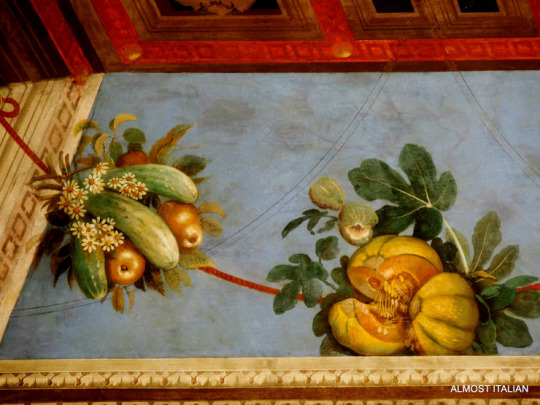
Suggestive coupling of fruits. New world fruits appear in the garlands of Udine.
The ground floor room, the stunning Loggia di Psiche e Amore, was designed by Raffaele, though is mostly executed by one of his followers Giulio Romano, and seems heavier in style. It’s not the best secular work of Raffaele: his most graceful works are held in the quiet gallery of Gemäldegalerie, in Berlin, Germany ( more on this gallery later). The decorative garlands and festoons are by Giovanni da Udine, and although hard to get close to, draped as they are on high ceilings and around tall window sills and pillars, they steal the show.
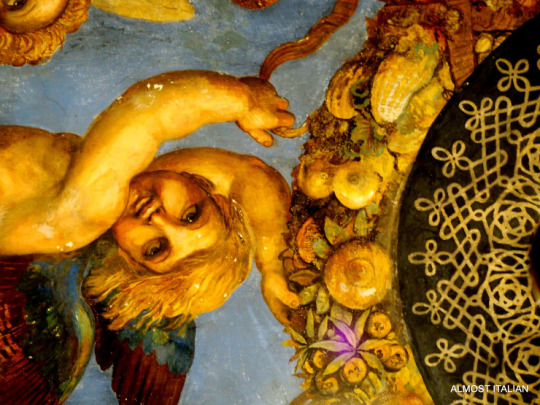

Sensuous and erotic, the total effect of the Loggia is complete in its aim and purpose. This is a pleasure palace, a space decorated with pagan themes of love and seduction from classical mythology, designed to amuse Chigi’s guests. The modern addition of a walled glass fronting the garden allows more light to shine on the rich colours and detail. It is delightful.
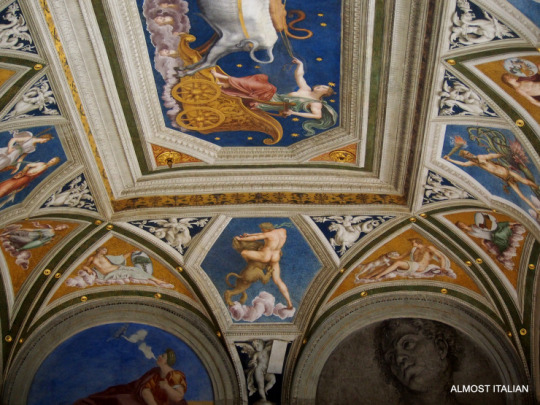
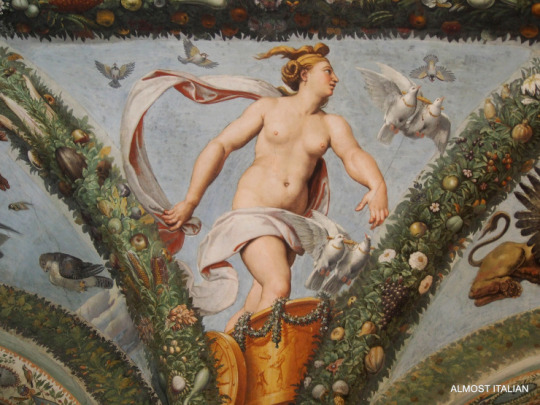
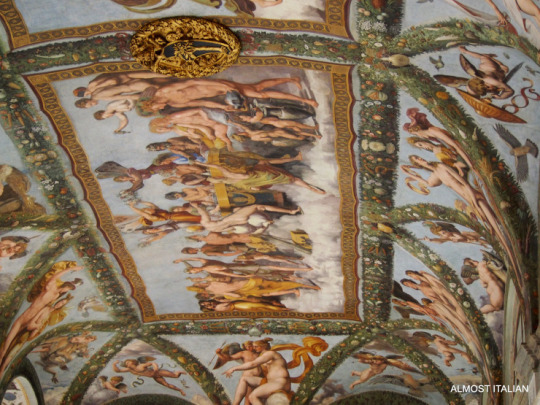
Upstairs in a smallish room, the wall panels by Il Sodoma, ( catchy nick name for the artist, Giovanni Antonio Bazzi , no two guesses why), depict scenes from the marriage of Roxana and Alexander. The total effect in such a small space visually overwhelming.
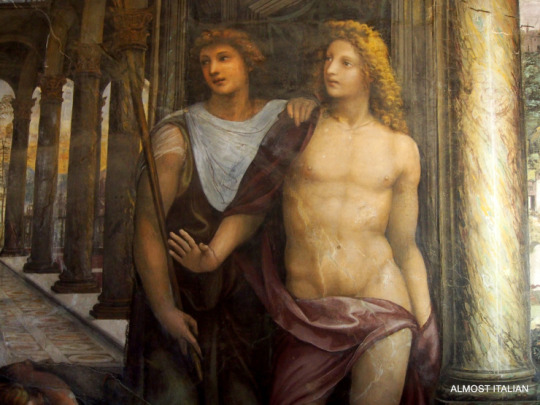
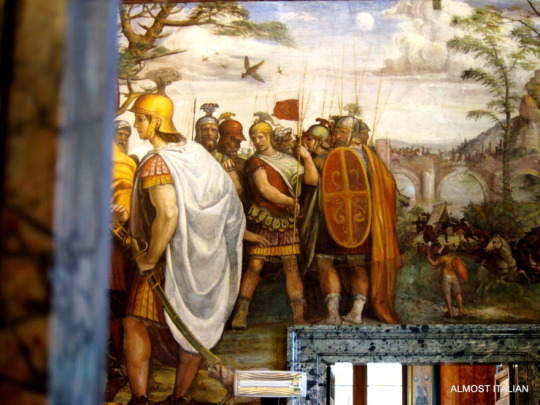
At the end of the 16th century, Villa Farnesina was bought by Cardinal Alessandro Farnese ( of course a Cardinal needs an erotically decorated villa) and its name “Farnesina” was given to distinguish it from the Cardinal’s much larger Palazzo Farnese on the other side of the Tevere. Today the Villa is the centre for the Accademia Nazionale dei Lincei, the Italian Science Academy and the rooms are open to visitors. Palazzo Farnese, across the river, is occupied by the French Consulate and is not open to the public.
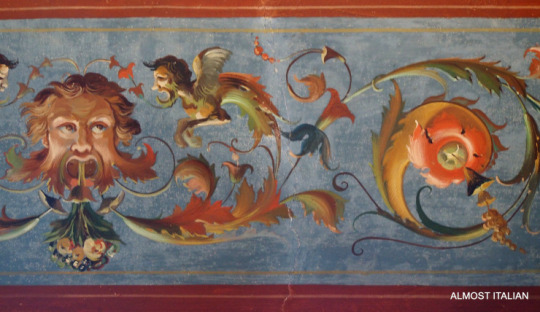
These small decorative motifs on window shutters and in cornices add to the overall aesthetic of the villa.
Some useful accompanying notes.
Giorgio Vasari, (1511-1574) author of Lives of the Most Excellent Painters, Sculptors and Architects, often simply called Vasari’s ‘Lives’, was the first art historian and the first to use the term rinascita ( Renaissance) in print, though an awareness of the ongoing “rebirth” in the arts had been in the air since the writings of the Florentine Humanist, Alberti, almost a century earlier. He was responsible for the use of the term Gothic Art, and used the word Goth which he associated with the “barbaric” German style. His work has a consistent bias in favour of Florentines and tends to attribute to them all the developments in Renaissance art. Vasari has influenced many art historians since then, and to this day, many travellers to Italy are blinded by Vasari’s Florentine list and bias, at the expense of other important works in Milano and Rome. Vasari, however, does recognise the works in the Farnesina.
¹ The nexus between banking and art patronage is fully explored by Tim Parks in Medici Money. Banking, Metaphysics and Art in Fifteenth- Century Florence,one of my favourite books. I am now re- reading this excellent history: it has an accessible style and makes for enjoyable summer reading, for those who enjoy reading about the Renaissance.
² Various papers on the festoons and garlands in the Villa Farnesina in Colours of Prosperity Fruits from the Old and New world, produced by the Accademia Nazionale dei Lincei and purchased at Villa Farnesina in Rome.

Agostino Chigi, 1506. Oil on canvas, anonymous.
Villa Farnesina is in the quiet part of Trastevere, well away from the tourist hordes in that precinct, and is very quiet in the month of November. Sadly the garden wasn’t open to casual visitors.
http://www.villafarnesina.it/
Via della Lungara, 230, 00165 Roma RM, Italy
Villa Farnesina, Rome. Who was Agostino Chigi? This summer throughout January, I'm catching up with some of my unpublished stories from earlier travels throughout Europe in 2017.
#Agostino Chigi#art#Classicism#Cosimo de&039; Medici#florence#freschi#Italy#patronage#Raffaele#Renaissance bankers#Renaissance patronage#renaissance popes#Roma#Rome#secular art#Tim Parks#Trastevere#Udine#Vasari#Villa Farnesina
0 notes
Text
A true blew Priest, ca. 1689
A true blew Priest, ca. 1689
[Copper plate digitally laterally reversed, note the Book of Common Prayer on the floor] “A true blew Priest, a Lincey Woolsey Brother. One Legg a Pulpitt holds, a Tubb the other, An Orthodox, grave, moderate, Prestbyterian. Half Surplice, Cloake, half Priest, half Puritan; Made up of all these halfes, hee cannot pass, For anything; intirely, but an Ass.” –altered slightly from Hudibras, p. 1, c.…
View On WordPress
0 notes
Text
// tag dump 03
general ship tags cont.
relations. ( “LYKAIOS” );
relations. ( “EMPEROR” );
relations. ( “GORGON” );
verses tags cont.
records. ( “OFFICIAL” );
records. ( “UNOFFICIAL” );
alternative records. ( “SUMMONED” );
alternative records. ( “HUNTED” );
alternative records. ( “CRIMINAL” );
headcanon tags.
notes. ( “CERBERUS” );
notes. ( “NIHIL” );
notes. ( “TALONSLASH” );
notes. ( “CONQUEST” );
notes. ( “FAMINE” );
notes. ( “HELIOS” );
notes. ( “STORMBRINGER” );
notes. ( “FLAMEDANCER” );
notes. ( “SPELLSINGER” );
notes. ( “BLOODSCALE” );
notes. ( “REVENANT” );
notes. ( “CETUS” );
notes. ( “LINCEI” );
notes. ( “LYKAIOS” );
notes. ( “EMPEROR” );
notes. ( “GORGON” );
#tags.#relations. ( “LYKAIOS” );#relations. ( “EMPEROR” );#relations. ( “GORGON” );#records. ( “OFFICIAL” );#records. ( “UNOFFICIAL” );#alternative records. ( “SUMMONED” );#alternative records. ( “HUNTED” );#alternative records. ( “CRIMINAL” );#notes. ( “CERBERUS” );#notes. ( “NIHIL” );#notes. ( “TALONSLASH” );#notes. ( “CONQUEST” );#notes. ( “FAMINE” );#notes. ( “HELIOS” );#notes. ( “STORMBRINGER” );#notes. ( “FLAMEDANCER” );#notes. ( “SPELLSINGER” );#notes. ( “BLOODSCALE” );#notes. ( “REVENANT” );#notes. ( “CETUS” );#notes. ( “LINCEI” );#notes. ( “LYKAIOS” );#notes. ( “EMPEROR” );#notes. ( “GORGON” );
0 notes